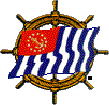 |
|
|
|---|---|---|
Flag and Etiquette Committee
|
Do It Right! |
|
|
|
||
Weather Pennants
Weather Pennants appear either individually or as doubles. When displayed as a pair, they indicate a more severe warning.
 |
Small Craft Warning up to 38 m.p.h. winds
  |
Gale Warning 39 - 54 m.p.h. Winds
 |
Storm Warning 55 - 73 m.p.h. Winds
  |
Hurricane Warning 74+ m.p.h. Winds
Diver Flags
Diving operations are indicated by flying one of two nationally recognized "Diver Down" flags, or navigation lights if at night. Either signifies a danger area. Stay well clear of diving operations because divers can easily stray from the diving vessel.

Code Flag "A"
International Code Flag "A" has several uses, one of which is to designate diving operations. The Inland Rules specifically require a boat, when engaged in diving operations and thus restricted in its ability to maneuver, to display a rigid replica of the International Code Flag "A". Exhibiting this signal invokes a special right-of-way of this vessel over essentially all other vessels. The key point is restricted in the ability to maneuver. Code Flag "A" is used only on a vessel. It should never be displayed on a diver's float, or raft. However, it is the practice of nationals of other countries to use the Code Flag "A" instead of the flag shown below. If the Code Flag "A" is seen on a diver's float or raft it should be treated as meaning: Caution - Diver Down
.
Diver Down Flag
A red square flag with a diagonal white stripe is also an accepted and recognized signal meaning: Caution - Diver Down. This flag is used on a vessel or on a diver's float, buoy, or raft to indicate diving operations. When divers are swimming free of the vessel, this would be the logical flag to use. The flag should be exhibited in rigid form. Many states have local laws requiring display of this "Diver Down" flag which has long been adopted by the Underwater Society of America.
When to Exhibit Each Flag
The distinction that the Coast Guard wants to make clear is this: The Alpha "A" flag is a navigational signal intended to protect the vessel from collision. The sport diver flag is an unofficial signal that, through custom, has come to be used to indicate a diver in the water. To be most effective, the Sport Diver's Flag should be exhibited on a "float" in the water to mark the diver's approximate location. The two flags, therefore, are not mutually exclusive, but may be flown together whenever their respective conditions both apply. The position of the Coast Guard is when in doubt, exhibit both flags. Neither is to be exhibited when underway to or from the scene of diving, or when divers are not actually in the water.

|
|
